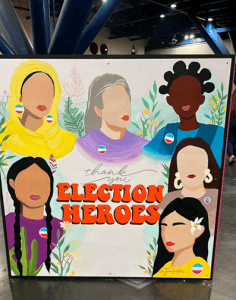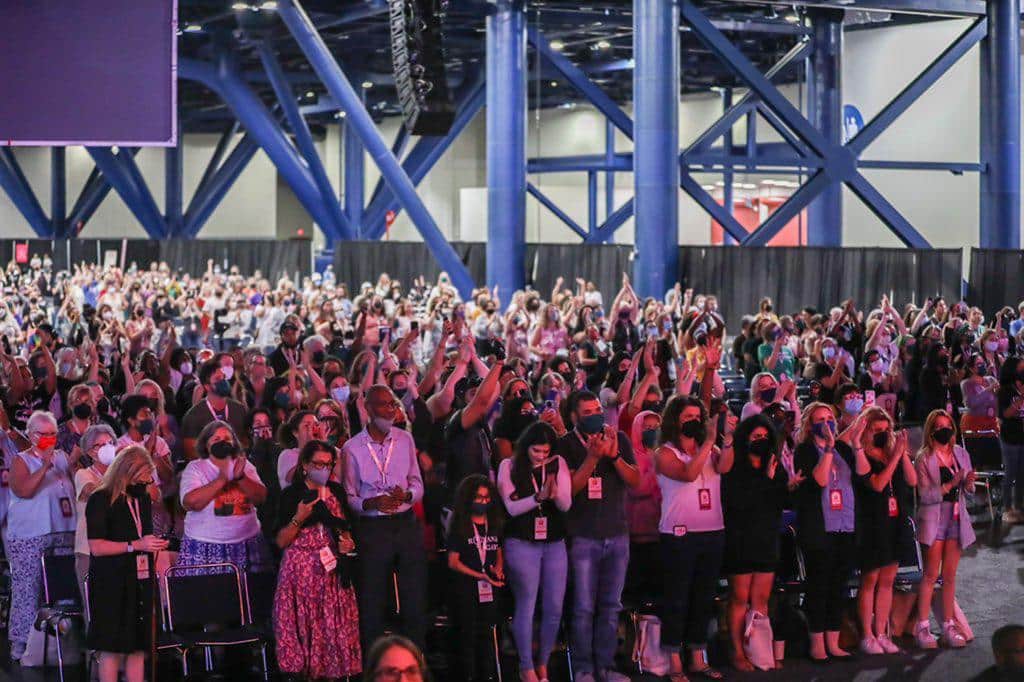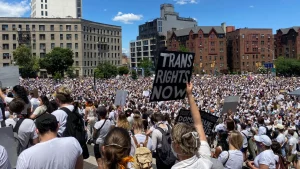On the weekend of August 12, over 1,700 people converged on Houston, Texas, for the Women’s March Convention.
Upon check-in at the almost $200 per night Hilton hotel, the convention displayed in the lobby beautifully painted “protest signs” that read “My Body, My Choice,” “El lugar de la mujer es en la resistencia (women’s place is in the resistance)” and “The whole damn system is wrong.” Images highlighted Black and Latinx women in particular, with radical imagery invoking the Black Panthers and indigenous women in struggle.
The conference was sponsored by the usual suspects — including the Women’s March, the National Organization of Women, and Planned Parenthood, as well as Emily’s List, Vote Run and Lead, Black Feminist Future, and more. It was also co-sponsored by corporations like Ben and Jerry’s, The Body Shop, and Mara Hoffman.
The Women’s March Convention was named “Summer of Rage,” which didn’t really fit. Yes, participants are furious at the stripping of our basic right to an abortion. But on one hand, the summer is basically over, and the Women’s March has organized essentially nothing all summer. On the other hand, the rage expressed by participants was being funneled to the most tepid solution: vote for the Democrats. It is a “solution” that has been tried over and over, and failed to protect reproductive rights over and over — so much so that Roe v. Wade was overturned while the Democrats held both the Congress and the Presidency.
The Women’s March Conference was a lot like the fancy Hilton Hotel we stayed at — the “radical” protest signs thinly veiled the real class content of the event.
The Political Context
It is important to situate this conference in its political context. A few months ago, it seemed nearly certain the Democrats would be trounced in the midterms. Inflation is at a 40-year high. Biden has broken nearly all of his election promises. And the Democrats have done absolutely nothing to protect abortion rights. Faith in institutions plummeted after the Supreme Court decision, and it seemed the whole system was headed for a crisis.
The Women’s March, Planned Parenthood, and the like refused to use their millions of dollars to build a real movement or even a major national protest for reproductive rights.
The referendum in Kansas, where nearly two thirds of voters supported keeping abortion legal, showed the path forward for the Democrats towards the midterms. They would use abortion, once again, to mobilize people to the polls. This maneuver comes while they are very literally spending millions of dollars to promote the most vile anti-abortion, anti-queer, anti-woman Republicans, giving them a platform and airtime and allowing them to promote their vile ideas, in hopes of gaining an easy 2022 Democratic victory.
It is in this context that the Women’s March held their conference — a conference that helps serve as a political tool for the Democratic Party.
Power to the Polls
Participants came from all over the country, mostly driven by anger and horror at the overthrowing of Roe and a fear of the far right. Participants who were isolated in small, right wing towns talked about being afraid of losing their jobs due to their political views. They also talked about moments of bravery — putting a rainbow flag up in a classroom, or on their porch, despite fear of the stigma. People talked about organizing protests against the overturning of Roe, even in very small towns, which put them in contact with the Women’s March. The will to fight in the folks who attended the Women’s March Conference was palpable; mentions of anger and rage got huge cheers from the audience. These are folks with whom we want to be in dialogue, in struggle, and in the streets.
The problem with the conference was with the political solutions being put forward by the leaders, not with the participants.
Long-time Democratic Party politician Sheila Jackson Lee, known for helping making Juneteenth a national holiday, as well as being the lead sponsor of the 2021 Violence Against Women Act, spoke at the conference and was lauded by the Women’s March. However, Lee is far from a leftist. In fact, she is in favor of more border security and against even a guest worker program. Yet, in her speech she spoke about the need to stand for “all women,” including immigrant women.
Throughout the conference, radical rhetoric thinly veiled the lack of radical solutions. At one panel, the speakers explained “Poor people are going to get poorer [as a result of the overturning of Roe]. We gotta start at race, class and gender and move from there.”
But on that very same panel, a panelist said, “The worst thing we got out there against us is not our opposition. It’s people who are with us and are starting to feel apathetic or like there is nothing they can do within this system.” Yes… the real problem are those of us who want nothing to do with this system that has denied us our basic rights over and over again.
Panelists went on to say, “We have a strong story of victory that is bigger and bolder than our story of loss. Y’all almost forgot that in 2018, we took back the U.S. House. Y’all almost forgot that a Black South Asian woman took the White House in 2020… Y’all almost forgot that Katanji Brown Jackson is on the Supreme Court.” The fact that Black women are in the highest posts of society, including the undemocratic Supreme Court and the Vice Presidency, is the direct result of the Black Lives Matter movement and of the ongoing struggle fo Black Lives. But having Black faces in high places has done nothing to protect abortion rights, for instance, and It has done nothing to address the exorbitantly high maternal mortality rate among Black women in particular.
The panel ended with participants being asked to make a vow: “I will volunteer for reproductive justice candidates this November.”
Even the decorations and swag highlighted voting as a strategy.

Without a doubt, newly activated people were at this conference. But the message to them was clear: you want to fight for your rights, you’d better head to the polls. There is no alternative. In fact, if you don’t get on board, you are part of the problem.
The Women’s March will be organizing a weekend of protest on October 7-9. But those protests are nothing but “get out the vote” rallies, which take place the weekend before voter registration ends. They aren’t mobilizations to build our power and strength in the streets; they are mobilizations to move people to the polls.
This is no surprise. After all, that was the slogan of the 2018 Women’s March — taking the millions of people who mobilized against Trump and funneling that rage into the midterms. And although the Democrats took the House, and even though the Democrats hold the House, the Senate, and the Presidency today, the right to an abortion was still taken away. This feminist movement has tried voting, and it clearly doesn’t work.
Liberal Intersectionality of the Non Profit Industrial Complex
The form of “intersectionality” promoted by non-profits conveniently forgets that we live in a capitalist system that profits from all forms of oppression. While rhetorically they claim to unite our struggles, in reality they’ve kept these struggles separate in the streets; the unity of our struggles is manifested for them at the polls and in the Democratic Party.
A feminism that wants to grasp our problems at the root should understand that all systems of oppression are currently inscribed within capitalism — and capitalism is a system that profits from all of our oppression. It’s a system that can only run due to the exploitation of workers — with the most exploited sectors being workers who are Black, Brown, and from the global South — for the profit of the very few. Working class women, especially working class women of color, are especially oppressed and especially exploited in this system: the Black women who work in UPS warehouses without air conditioning, the Mexican maquila workers, and the domestic workers who send money to their children back home every month.
At the same time, the multi-racial and multi-gender working class is in a unique position to shut down the economy in service of our demands as workers and oppressed people because we make everything run. This may be a limit of intersectionality as a framework: even its left iterations miss the strategic position of the working class in the day to day function of and profit-making of capitalism. But this conference was not a leftist iteration of intersectionality: it was liberalism that brushes over the existence of capitalism and glorifies exploitative bosses. And there is no such thing as liberatory capitalism. It’s impossible to even imagine our liberation within a system of private property and exploitation, in which the bosses profit from the unpaid labor in the home overwhelmingly done by women and profit from our low wage labor in the workplace.
A feminism that grasps our problem at the root understands that corporations have no place in our movement — including “progressive” corporations like Ben and Jerry’s that actually union bust, whose CEO makes over 17 times what a worker makes and supports the Zionist state of Israel.
But it’s not just corporations that are exploiters; nonprofits are a pillar of the exploitative capitalist system. At the conference, I met a young Black woman who was fired in a process of attempting to unionize her workplace, a non-profit that co-sponsored the event. “I know how much the CEO makes… and it’s a lot,” she said to me, “Everyone who was trying to unionize has left. We’ve been pushed out.” In the end, the liberal intersectionality of the Women’s March, as well as the countless non-profits who spoke and co-sponsored the conference, is merely a cover for the oppressive capitalist system.
I met another young person who put her finger on the problem: “If the higher-ups at these nonprofits make bank from addressing our oppression, it’s not really in their interest to solve the problem, is it?”
And this is the crux of the issue. The radical movements for women’s liberation and queer liberation of the 60’s and 70’s have been moved into non-profits and defanged. While progressive rhetoric and discussions of liberation remain, these same non-profits play an essential role in maintaining the movement entirely subservient to the capitalists — in the Democratic Party, but also in “progressive” corporations.
The Way Forward
While the Women’s March conference was supposed to be about “empowering women,” the message being peddled was exactly the opposite. These people pretend to be the champions of women, but they do not trust women to fight for their own interests. The message is that the power is not with us — it’s with politicians that do not represent or support us.
The Women’s March wants to take a whole generation of new activists from all over the country to the polls, fostering illusions in the Democratic Party and in a system that has been created to exploit workers, where Black and brown workers are the most hyper-exploited. They use the imagery and the language of transgressive movements of the 60’s and 70’s, movements that were defanged by the non-profit industrial complex and the Democratic Party in the neoliberal era.
We needed a summer of rage. But we didn’t get that. Planned Parenthood, Women’s March, and the other groups that co-sponsored the meeting had no interest in organizing one. They were interested in all that rage being bottled up and directed at the right moment.
Now they want that rage to be directed to the polls to vote for the Democrats. And that was what the Women’s March conference was primarily about.
There will be protests on the weekend of October 7 called by the Women’s March. And despite the serious limitations of the Women’s March, we as socialists should participate.
We want people to be in the streets. We want to be in dialogue with all of those folks who want to fight back– all those thousands of people who attended the convention, and all those millions who are angry at the attacks on our rights. But we should be clear that we have very different goals from the Women’s March. While they try to push our power to the polls, we want to build an independent power; we want to build power in the streets and in our workplaces.











